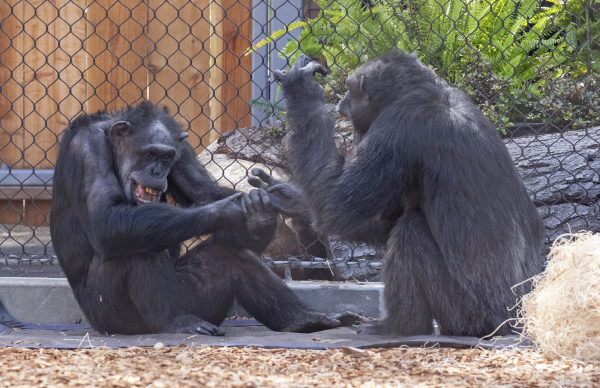Chimpanzee
Pan troglodytes

At the Zoo
In 2019, we introduced four new chimpanzees (two males and two females) transferred from other zoos to be a part of our existing and long-time chimpanzee group as recommended by the Chimpanzee Species Survival Plan (SSP) Management Group, which oversees chimpanzees living in AZA accredited zoological parks. All new members are adults, and have joined together with our senior group.
Median life expectancy for chimpanzees in the wild is forties to fifties; in zoos, chimpanzees often live well beyond average life expectancy thanks to advanced animal and veterinary care. Our Wellness Initiatives contribute greatly to their longevity, which includes preventative and individualized care and meeting the unique needs of senior animals through enrichment and adjustments to their environment.
The opening of a spacious, expanded habitat, Great Ape Passage, has also offered stimulation, excitement and a new way of life for the chimpanzees with options of indoor and outdoor respites, climbing structures that include elevated platforms, hanging fire hoses, steps and ladders and even a climbable mesh. While our chimps enjoy climbing and relaxing in their outdoor yards, they are also given access to their inside rooms because of their ‘senior’ status. Inside they can warm up, take a break, participate in training or interact with their keepers, or engage in specialty enrichment activities like painting.
The Zoo’s chimpanzee group is comprised of two males (“Gombus” and “Michael”), and four females (“Maggie,” “Minnie,” “Beth” and “Connie”). Beloved senior male “Cobby” passed away at 63 in 2021 as the oldest male chimpanzee in a North American zoo.
Fascinating Facts
- These adaptable animals are known for making and using simple tools, such as twigs for eating termites and rocks for cracking nuts. They will also create leaf “sponges” for getting water out of tree-boles and crevices.
- Chimpanzees, and their cousins the bonobos, are more closely related genetically to us – sharing 98.4% of our DNA – than they are to gorillas!
Physical Characteristics
The hair of these tree-dwelling animals is long and coarse, usually dark brown or black. Baldness is common and more extensive in females. Males weigh from 126-176 pounds, while females weigh from 100-150 pounds. Long and muscular arms allow them to move easily through trees but most locomotion is done on all fours by knuckle-walking. Chimpanzees are capable of walking on their hind legs as well, but only with the toes turned inward. Chimps have opposable thumbs used for climbing, using tools, grooming, and grasping food.
Lifespan in the wild is about 50 years, and up to 60 years under human care.
Habitat/Diet.
The chimpanzee range includes equatorial forests of west and central Africa; in rainforests, deciduous forests and savanna woodlands.
As omnivores, they feed on a variety of fruit, leaves, seeds, bark, honey, insects and eggs. Chimps will also regularly work together to hunt other primates and small animals. At the Zoo, the chimps are fed a variety of foods, such as fruits, vegetables and monkey chow.
Social Behavior
Chimpanzees are highly intelligent and live in complex social groups. These groups can include 15-150 individuals but a few dozen is typical, with at least two levels of social units. One adult male is dominant, although in larger groups dominance can be shared among several males. It is rare to find the whole community in one place. Whenever possible, they eat large meals from a single food source so that they can rest an hour or two before going to the next tree to eat. Chimps build a tree nest of vegetation each night. Adults sleep alone, and infants sleep with their mothers until the next sibling is born.
Chimpanzees rely on several forms of communication including vocalizations, facial expressions, body language and grooming. Groups are territorial and will use vocalizations to reinforce boundaries, although violent conflicts are not uncommon.
Female chimps do not give birth until they are about 13 years old, with births every 5 years or so afterward. Maternal bonds are very strong, with the young staying with the mother until they are at least five to seven years old, although weaning starts in the third year. Juvenile males will remain with the birth group, while females will leave to join another group by the time they reach sexual maturity.
Status In The Wild
Chimpanzees are listed as endangered by the IUCN. Populations have been reduced due to habitat loss, hunting for bushmeat and collection for animal trade. In 1976, the USDI classified this species as threatened which resulted in regulations reducing legal importation to the U.S. They were reclassified as endangered in the wild in 1990, which strengthens regulations covering animals in captivity. Although chimpanzees are the most abundant and widespread of the apes, with many populations in protected areas, the declines that have occurred are expected to continue unless significant progress is made toward conservation.
What can you do to help chimps?
- Buy sustainable wood and paper products! Deforestation is a major threat to chimp populations so by purchasing FSC Certified paper and wood you can help protect their habitat.
- Consider supporting conservation organizations that are working to save this incredible and charismatic species.
- Spread the word about chimp conservation!
